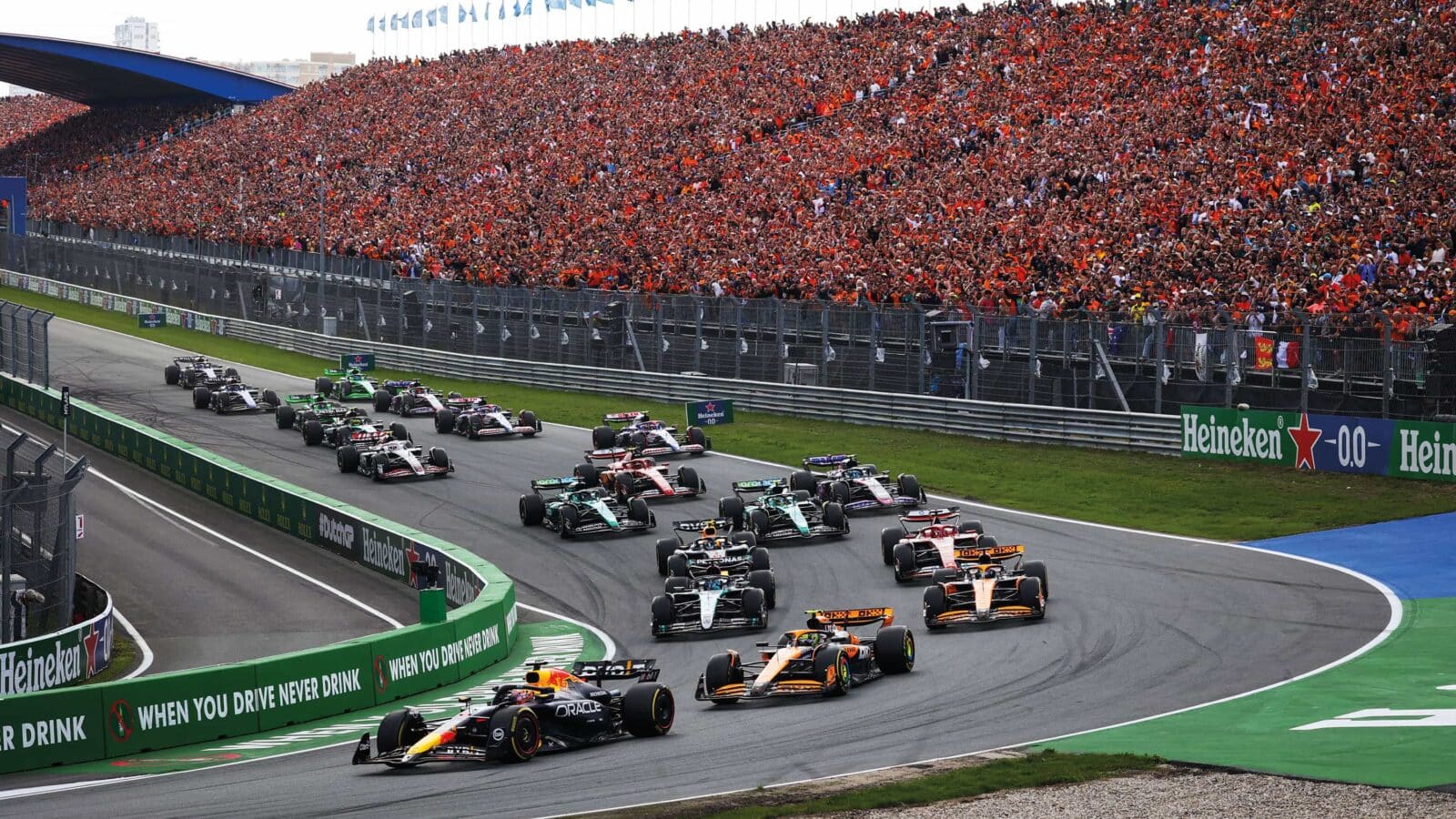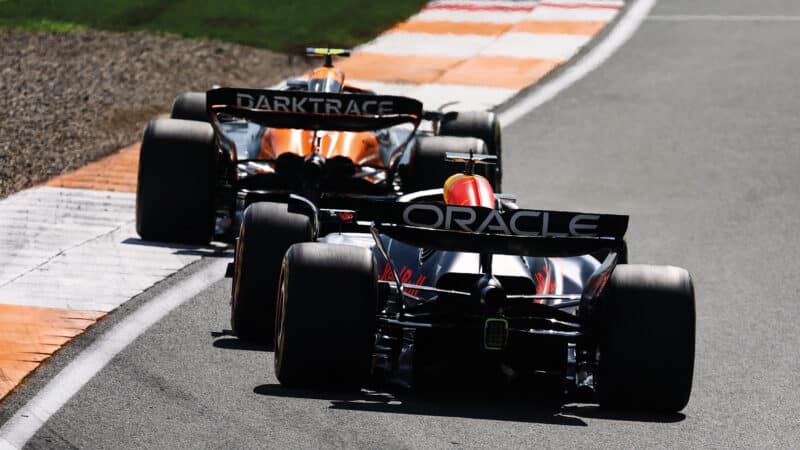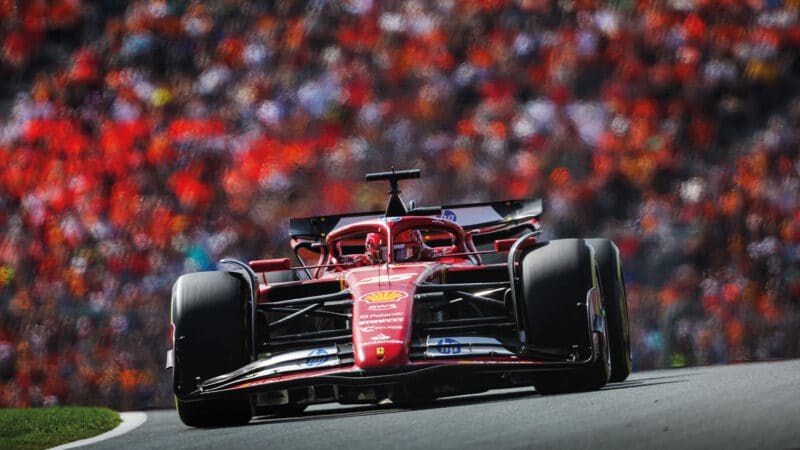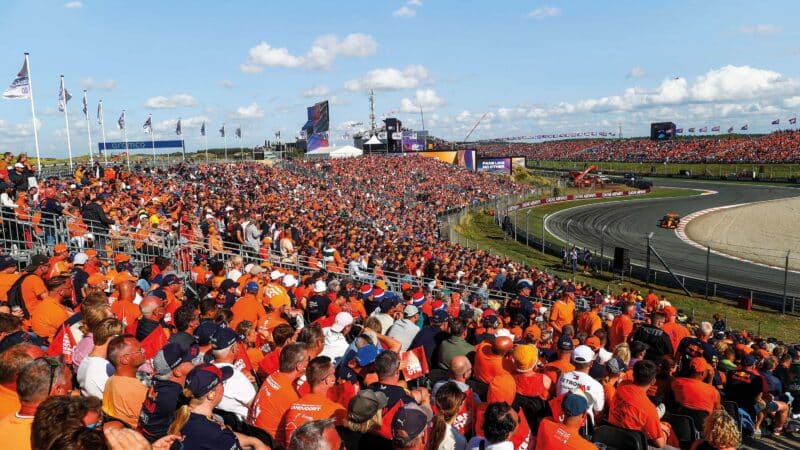Red Bull’s aero error that backfired cost them the Dutch GP
Verstappen was looking for a fourth successive Dutch GP win but a McLaren upgrade upset the party – as Mark Hughes explains

The usual mass of orange at Zandvoort – and there was delight for the fans as Max Verstappen jumped Lando Norris into Turn 1
DPPI
There was something symbolic about Lando Norris’s resounding victory over Max Verstappen at the latter’s home ground of Zandvoort. The McLaren driver delivered the sort of crushing performance which has always looked within him but which for various reasons had eluded him and in so doing brought Verstappen’s 100% record here to an end as the modern version of the classic track hosted the event for the fourth time.
The McLaren was comfortably the fastest car around the sort of long, interconnected corners which so suit it, just as it had been at the Hungaroring. But this time the advantage was exaggerated by: 1) Red Bull making a couple of key component choices – an old-spec floor and a barn-door full-downforce rear wing – which backfired; 2) the McLaren was running a very effective aero update which retained the car its benign balance while enhancing its downforce.

Once in front Norris’s position strengthened, his supremely quick McLaren powering away.
Although Norris was beaten away from his pole position slot by the Red Bull, he was able to pass it on track after 18 of the race’s 72 laps and in the remaining distance pull out over 20sec over what had been F1’s dominant car at the beginning of the season. McLaren has made fantastic progress over the past couple of seasons and it now fields what is accepted as F1’s fastest car. But Zandvoort saw it in the most flattering light possible: around the perfect layout for its traits and against a badly compromised Red Bull.
“This whole weekend, I think we’ve had the best car,” said the two-time grand prix winner. “I think we’ve, on average, had the best car. But we’ve not had a dominant car at any point this season, I would say. Even if you go back to Hungary, Max was still very quick in Hungary. He just didn’t have a great race, but his pace was still very, very strong. And obviously we see more information than people do on the outside, so we can comment in much more factual ways than people can who are just watching on TV and taking their picks and guesses.
“We probably should have won two or three more races as a team, but we didn’t. And we’re not saying anything more than that. We should have won and we didn’t, and it’s because we’ve not done a good enough job. I didn’t do a good enough job. And we worked hard over the summer break to just try and take a step back and reset and go again and this was the first time we brought some good upgrades to the car since Miami. They worked very well then. They’ve worked once again now.
“But it’s still a long way to go and we still have to keep working as hard as we can because this is just Zandvoort. There are other tracks which are very different.”
The wild and windy conditions of the weekend favoured the progressive McLaren more than the tricky Red Bull or the tyre-sensitive Mercedes. With two of the three practice sessions wiped out by rain and a powerful but variable wind blowing, confidence in the car’s feel was worth even more lap time than usual in qualifying. The McLaren was the car which provided that and Norris responded with a stunning pole lap, 0.356sec clear of second-fastest Verstappen.
“We should have won two or three more races as a team”
Added to the car’s usual benign balance was the MCL38’s aero upgrade centred around a much more efficient high-downforce wing, bringing that part of the car up to date with the similarly effective Red Bull wing. The car’s balance was unchanged, reported Norris and third-fastest Oscar Piastri, but the loads were higher. Around the long corners of Zandvoort it was formidable. Piastri didn’t find anything like as much as Norris from his final run, compromised on his tyre-prep lap by having to move aside so as not to impede the end of Pierre Gasly’s flying lap in the improving Alpine. With his tyres slightly under temperature at the start of the lap, Piastri suffered a snap through Tarzan and a poor run through the banked Turn 3.
As a car with an apparently narrow set-up sweet spot, the loss of practice time made the Red Bull a challenging ride over a push lap even for Verstappen. “The car didn’t feel like this at the beginning of the season,” said Verstappen, giving some background to why he chose to revert to the early season floor from Saturday onwards. But in combination with a full Monaco wing which was chosen in the expectation of high rear tyre degradation, it still didn’t give him the balance he sought.
“Every run, there were always one or two corners where I felt like I was losing a lot of time with just the gust of wind,” he said after qualifying, “and it seemed like it was very sensitive for us. The car was really responding aggressively to it. And that’s why I think every single run that I did it was different. It was just a different balance every time.”

GP win number two for Lando
DPPI
Piastri wasn’t the only one compromised by tyre temperatures as the circuit cooled from the overcast skies. It completely tripped-up Mercedes, with Lewis Hamilton going out in Q2, only 11th fastest (later taking a three-place grid drop from there for impeding) while George Russell at least made the outside of the second row, albeit half a second adrift of Norris. “In reality I think our car is only maybe half a tenth or a tenth slower than the McLaren here,” he said. “But it’s all about the tyres. You want to start the lap with your tyres as cold as possible but if you go one degree below the limit you’ll probably lose half a second. If you’re one degree over, you lose a tenth. It’s like you’re edging closer to the edge of a cliff, and you go one step too far and you’re off. I was on a really strong lap, I was matching Lando I think, two and a half tenths up on myself, then the tyres were overheating and I just lost more performance than I expected in the last half of the lap.”
Ferrari returned from the summer break in much the same trouble as it left, with a car which needs to be run relatively high to avoid bouncing and thereby losing a lot of underbody downforce. Charles Leclerc was the only one of the red cars making it into Q3, with sixth-fastest time behind Sergio Pérez’s Red Bull (which was running the later floor and a less-extreme rear wing than Verstappen). Carlos Sainz, after losing a practice session with a gearbox failure, didn’t get his Ferrari attuned to his liking and was only 12th-fastest. Lining up behind Leclerc were the Aston Martins of Fernando Alonso and Lance Stroll, 65 years after the marque’s F1 debut at this very track.
The under-performances of Hamilton and Sainz created Q3 opportunities seized upon by Williams (Alex Albon) and Alpine (Gasly). Albon qualified the heavily updated FW46 eighth-fastest, within 0.1sec of Leclerc, but was excluded from qualifying, see left.
The rain had gone by race day but not the wind, strong gusts blowing down the main straight as the cars sat on the grid. As the lights went out there was a certain inevitability about Norris losing out at the start – just as he had in Barcelona, Hungary and Spa. It seemed a potentially race-losing repeat for him but turned out to be nothing of the sort, such was the pace advantage at his command. But startline performance does seem to be a weakness. On the row behind Piastri, in the sister car, lost out to Russell’s Mercedes.

Charles Leclerc’s seventh podium of 2024 keeps him third in the drivers’ championship
“Because we both didn’t get it right, it seems like maybe there is a more underlying issue or something wasn’t how it was supposed to be,” said Norris. “Oscar’s one of the best starters on the grid. I’m not as good as him, but there or thereabouts. I’m not a bad starter, but not as good as we need to be.”
Whatever, the crowd roared its approval as Verstappen headed everyone into Tarzan, Norris hanging on ahead of Russell, Piastri and Leclerc. Norris filled Verstappen’s mirrors for a couple of laps as they both put distance on Russell. This gave Norris the luxury of backing away from Verstappen, just out of turbulence zone to help preserve his tyres without being vulnerable to the Mercedes. But the McLaren was never more than 1.5sec behind as the laps went on and it was obvious that this Dutch Grand Prix wasn’t going to be the straightforward Verstappen run of the previous three.
Norris’s moment of realisation of his greater pace came early. “From about lap six to seven, I could see Max wasn’t pushing on and I felt we were just getting faster and faster. He was clearly using up his tyres and mine still felt good.”
“The crowd roared its approval as Verstappen headed into Tarzan”
By the 12th lap Verstappen was on the radio reporting, “The car just doesn’t want to turn at Turn 10.” That big rear wing fitted to protect the rear tyres wasn’t helping the car’s inert understeer balance through the long corners and it was his front tyres which were suffering. The tyre degradation as the track rubbered-in after the rain of the previous two days was way less than had been predicted. The rears didn’t need such protection, but Verstappen was saddled with the downsides of that big wing – understeer which was eating through the front tyres and a slow end-of-straight speed.
Norris and his engineer had been discussing whether the way to beat Verstappen would be to undercut him early and switch to a two-stop. But then came the realisation that they had no need for such complications: as Norris edged back into the DRS zone he’d surrendered earlier on, and saw just how much quicker he was at the end of the straight, it became apparent he’d be able to pass him on track long before the pitstops. He had a look into Tarzan going into lap 17, then pulled the move much earlier and more decisively on the next lap. Verstappen was completely defenceless.
Norris’s engineer Will Joseph cautioned that Verstappen might try to undercut them – until Norris took such concerns away by simply sprinting away into the distance, well out of any undercut range. It was one of the most dominant performances from anyone in ’24.
Verstappen could at least be thankful that Russell some distance behind him was in even worse trouble than him – and in the process was keeping the potentially faster Piastri from further punishing the Red Bull.

A Norris win might not have been what the home crowd wanted to see, but Verstappen’s fourth world title looks beyond doubt
Getty Images
“Today’s race was an odd one,” reported Russell. “We didn’t have the pace and that was the case on all three tyre compounds. It felt that I was sliding around quite a lot, suffering from high degradation, and slowly went backwards. We will have to understand why that was as we were relatively quick on Saturday. Performance does swing circuit to circuit, but we have been up near the front in the past six races. I am therefore confident that this is an outlier.”
Hamilton in the sister car was making his way through the midfield on an unambiguous two-stop strategy from his penalised 14th place on the grid. But his pace wasn’t as strong as that of Sainz’s one-stopping Ferrari which was soon up with Pérez on the tail of the Russell-Piastri-Leclerc train.
“Running serene at the front, Norris extended his gap”
Leclerc was the first of the leading cars to pit, Ferrari going for the undercut on Piastri and Russell on lap 24. Russell responded, but suffered a slow pitstop and lost the place. Piastri stayed out even as Verstappen and Norris pitted on laps 27 and 28 respectively. McLaren was trying to maximise the tyre advantage he’d carry into the second stint, but staying out had dropped him a further place. With tyres eight laps newer, he was able to pass Russell on track comfortably enough. But in his chase of Leclerc, he used up the best of his tyres. “I could see he was much faster,” said Leclerc. “At times maybe 1sec faster. But then as he got close I pushed a little and found maybe 0.5sec and after a while he no longer had the advantage and I was safe.” It was a beautifully judged drive from Leclerc to third place.
Sainz, having passed Pérez in committed style around the outside of Tarzan, was closing fast on Russell. Mercedes switched him to a two-stop before the inevitable pass happened, this losing him a further place to Pérez but in the belief he’d have the pace on a set of fresh soft tyres to reclaim those places. He did not and in pushing hard, he probably damaged them – as team-mate Hamilton was now catching on soft tyres considerably older. A subdued 7-8 finish for the very same Mercs which had been 1-2 across the line at Spa left everyone there very puzzled.

With two world championship GP wins, Norris equals the likes of Jo Siffert, Wolfgang von Trips and Pedro Rodriguez
Sam Bloxham / McLaren
They were however a long way clear of the ‘best of the rest’ outside the big-four teams which this week was Pierre Gasly who delivered strongly for Alpine all weekend. Having qualified in Q3 he proceeded to fight past the Aston Martins and Nico Hülkenberg’s Haas to take ninth, with Alonso’s Aston the final points scorer.
Running serene at the front in clear air, Norris extended his gap over Verstappen on each subsequent lap until by the end it was over 20sec, with Max doing just enough to keep Leclerc off his back. Norris had one last flourish in store. With his battery fully charged, he let rip with full deployment on the final lap – and duly took the point for the fastest lap of the race.
“I wouldn’t say a perfect race,” said Norris, “because of lap one again, but afterwards it was beautiful. The pace was very strong. The car was unbelievable today.”

